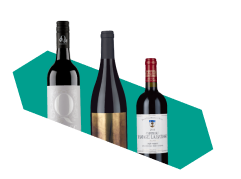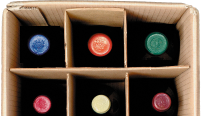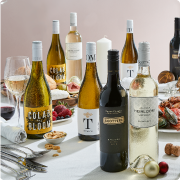When choosing between red and white wine, there’s more to think about than just the colour. Each type has its unique traits. Knowing these differences can help you find a new favourite or even change your preference from one to the other.
To explore without spending too much time or money, consider joining a wine club. This lets you try different wines risk-free right from home.
Find out more about our wine memberships.
In the meantime, read on to discover the similarities – and differences – between red and white wine beyond the obvious!
Red wine vs white wine – how wine is made
Despite their colour, taste and style differences, red and white wines are made using similar processes.
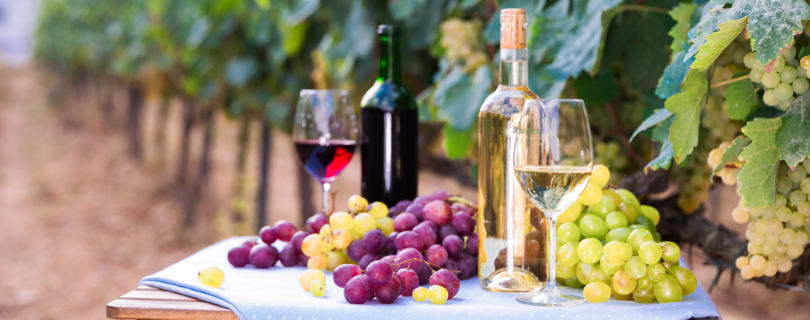
Red wine
All grape juice is naturally clear – and the ‘red’ in red wine comes from black and red grape skins.
Popular grape varieties for red wine include:
Thanks to the unique characteristics of each grape variety, the shade of red wine they create can vary – ranging from light ruby to deep purple.
After the red wine grapes are picked, stems are removed, and the grapes are lightly crushed to release the juice.
The skins and seeds are left to soak in the juice – a process known as maceration – which adds tannins and colour to the wine.
The grape skins and seeds can soak for a few hours or several days, depending on the winemaker’s preferences. The longer they soak, the deeper in colour and more structured the wine becomes.
Fermentation starts when yeast is added to the grape juice. This converts the natural sugars in the juice into alcohol. Skins and seeds continue soaking, enhancing the colour and depth of the wine. Once the skins and seeds have been removed and fermentation reaches the desired level, the wine can be aged.
Ageing can take place in various types of vessels, including wood barrels, stainless steel tanks and clay amphorae (a type of pot). The choice of vessel influences the wine’s unique secondary flavours and aromas. If a winemaker is making a blended wine, the blending process often happens at this stage.
Before the wine can be bottled, it is usually filtered and/or fined to create a smoother texture and improve its clarity. Depending on the winemaker’s plan, the wine may be further aged in the bottle.
White wine
The process for making white wine is similar to red wine – the grapes are harvested, destemmed and then lightly crushed to release their juices.
Some of the most popular white and green grape varieties used for making white wine include:
One or two black grapes can also be used to create white wine, including Pinot Noir, which is used for making Champagne.
Despite contributing very little to the colour of the wine, winemakers may macerate the white or green grape skins for a short time to add more flavours and aromas. If the grape skins are left to soak long enough, the wines can take on an orange or amber hue. Unlike the red wine production process, white wine grape skins are removed and discarded before fermentation begins.
The fermented white wine is aged in oak barrels, stainless steel tanks, cement tanks or clay vessels.
Stainless steel tanks are the most popular choice, as they help preserve the wine’s fruity, fresh character. On the other hand, oak barrels create richer, smoother white wines, allowing the wine to be slowly oxygenated.
Some white wines also undergo a process called ‘malolactic fermentation’, which can add richness and creamy flavours (this takes place when winemakers introduce or encourage specific bacteria to convert the malic acid in wine into lactic acid and carbon dioxide).
Once the white wine has been aged, it is typically filtered and/or fined before being bottled and sold. Some white wines are aged again in the bottle.
Red wine vs white wine – flavours and aromas
The flavours and aromas in wine are influenced by several factors beyond the grape variety, including vineyard location, climate and geography.
However, many wines share common notes, such as spices and berries in red wines and citrus and floral elements in white wines.
Red wine
Red wines are typically packed with rich, warming flavours of black and red berries, orchard fruits, baking spices, herbs, chocolate and savoury, earthy notes.
Here are some of our most popular red wines and the typical flavours they feature:
Merlot – Tastes like ripe plum, black cherry, and raspberry, with hints of chocolate, vanilla and subtle earthy notes.
Shiraz – Features dark fruit flavours like plum and blackberry, with spicy notes, black pepper, dark chocolate and sometimes a smoky, almost meaty character.
Cabernet Sauvignon – Known for its bold dark fruit flavours, such as black cherry and blackcurrant, alongside notes of black pepper, tobacco and a hint of vanilla if oak-aged.
Malbec – Deep and rich with blackberry, plum, black cherry and sweet tobacco flavours, plus aromas of violet, raisin and black pepper. Oak aging adds cacao and vanilla hints.
Pinot Noir – More delica
te than Shiraz and Cabernet Sauvignon, look for brighter notes of cherry, strawberry and raspberry, plus a savoury undertone featuring leather, earth and spices.
Grenache – Offers flavours of ripe red berries like strawberry and raspberry, with notes of spice and white pepper, plus hints of earthiness.
Shop our full selection of delicious red wines.

White wine
White wines are on the opposite end of the flavour and aroma spectrum. Where red wines are typically juicy, deep and complex, white wines are usually refreshing and bright. Common notes include citrus, stone fruits, tropical fruits, white blossom and fresh herbs.
Some popular white wines include:
Sauvignon Blanc – Packed with bold aromas ranging from freshly cut grass to tropical fruits. Expect crisp gooseberry, passion fruit and zingy citrus flavours, plus hints of white peach.
Chardonnay – In cooler climates, it has flavours of green apple, pear and citrus with a mineral touch. Warmer areas bring out pineapple and mango. Oak aging adds vanilla and buttery notes.
Pinot Grigio – Known for being light-bodied with flavours of green apple, pear and citrus, plus floral aromas. In warmer climates, honey and ripe tropical fruit flavours develop.
Riesling – Look for aroma
s of tart citrus, stone fruits and floral notes of jasmine. Riesling has bright lime, green apple, pear and lemon flavours, plus sweeter notes of pineapple and beeswax.
Pinot Gris – Features flavours of ripe pear, apple, and citrus, along with stone fruits like peach and apricot, often with floral and honeyed undertones.
Shop our selection of premium white wines.

Red wine vs. white wine – perfect food pairings
Pairing the right wine with the right food can enhance the flavours of both the food and the wine as they complement or contrast with each other.
One approach could be to match colour, flavour and texture. For example, a full-bodied, fruity, robust red wine could be paired with a hearty meal featuring red meat and a fruity glaze. However, the perfect food and wine pairings will always come down to personal taste.
Here are some delicious food pairings you might want to try with your next red or white wine:
Red wine
Red wines are fuller-bodied with higher tannins, making them great with rich meats that balance their acidity.
For example, a hearty Cabernet Sauvignon or Shiraz pairs well with slow-roasted lamb or grilled steak, as the tannins cut through the fattiness of the meat.
Try Pinot Noir with roast chicken, vegetable pizzas or mushroom risotto for something lighter. The earthy notes in this wine blend perfectly with these dishes, adding depth without overpowering the flavours.
White wine
White wines are refreshing and lighter, ideal for dishes like chicken, fish and salads. Their high acidity also makes them a great partner for dishes featuring rich, creamy sauces, refreshing your palate between bites.
Sauvignon Blanc, for instance, is great with a tangy goat’s cheese salad or grilled white fish, thanks to its bright acidity and citrus zing.
A fuller-bodied Chardonnay with its toasty and buttery secondary flavours complement richer dishes like lobster, roast pork or creamy pasta, adding a touch of indulgence to your meal.
Discover the basics of food and wine pairings.
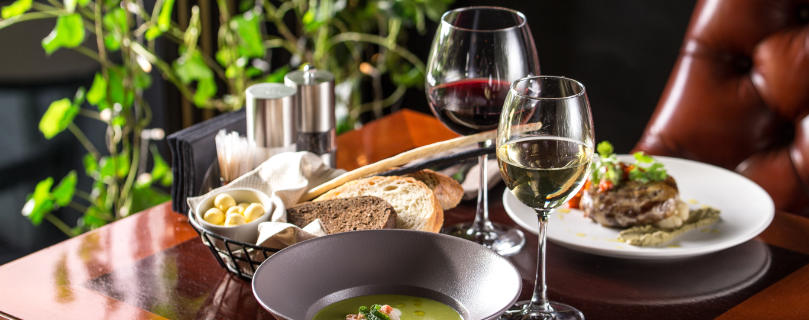
Do you have to pair red with meat and white with fish?
You certainly don’t have to pair red wine with red meat and white wine with white meat or fish.
Despite being a fish, a simply cooked fillet of salmon can pair exceptionally well with a glass of light Pinot Noir, a red wine. Meanwhile, a buttery, bold Chardonnay can be a wonderful partner for a perfectly cooked steak.
It’s down to personal preference, so don’t worry about ‘rules’ – just remember to consider acidity, body and texture when you’re looking for the best wine pairing for your meal.
Wine subscriptions – red, white or both?
Now that you know everything about the differences between red and white wine, how do you choose which one to try first?
A Laithwaites’ Wine subscription can send you a box of 12 mixed wines to your door every month. Discover premium wines in different styles from Australia and beyond and find your new favourite, whatever the colour.


